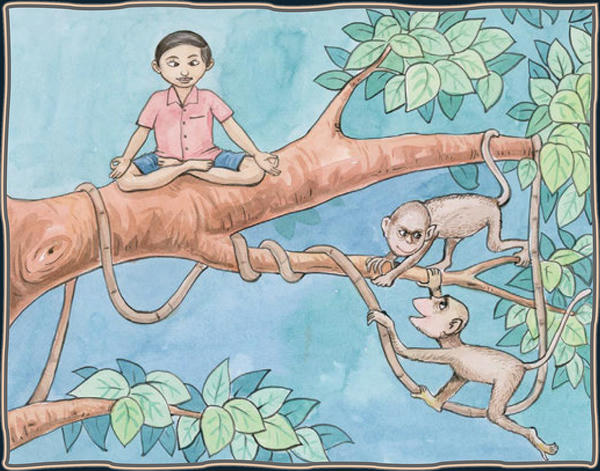
On reaching the seventh branch, the boy sits in full lotus posture, focuses his gaze on the tip of his nose and holds his thumbs and index fingers together to direct the body’s pranas. He is striving for the state of meditation. Two chimps play nearby, uncontrolled and uncontrollable, a reminder of the monkey-like mind that jumps from place to place.§
After we are able to hold awareness hovering over that which we are concentrating upon, we come into great powers of observation. We are able to look into and almost through that which we are concentrating upon and observe its various parts and particles, its action and its reaction, because we are not distracted. Even observation in daily life, as a result of regular participation in the practice of concentration, comes naturally. We are able to see more, hear more, feel more. Our senses are more keen and alive. Observation is so necessary to cultivate, to bring awareness fully into the fullness of meditation.§
This leads us then into our very next step, meditation. Meditation and concentration are practically the same thing, though meditation is simply a more intense state of concentration. The state of meditation is careful, close scrutiny of the individual elements and energies which make up that flower. You are scrutinizing the inner layers of the mind, of how a flower grows, how the seed is formed. You are observing it so keenly that you have forgotten that you are a physical body, that you are an emotional unit, that you are breathing. You are in the area of mind where that flower exists, and the bush that it came from, and the roots and the seed and all phases of manifestation, all at the same time. And you are seeing it as it actually is in that area of the mind where the flower is that you first put awareness at attention upon, then began to concentrate upon. Then you are meditating on the actual inner area of the mind where, in all stages of manifestation, that particular species actually is within the mind.§
When you are experiencing the totality of the moment, you are not aware of the past, nor are you aware of the future or anything within the externalities of the mind. You are aware of the ākāśa, the primal substance of the superconsciousness of the mind. You are able to have a continuity of intuitive findings within it and gain much knowledge from within yourself.§
As you sit to meditate, awareness may wander into past memories or future happenings. It may be distracted by the senses, by a sound or by a feeling of discomfort in the body. This is natural in the early stages. Gently bring awareness back to your point of concentration. Don’t criticize awareness for wandering, for that is yet another distraction. Distractions will disappear if you become intensely interested and involved in your meditation. In such a state you won’t even feel the physical body. You have gone to a movie, read a book or sat working on a project on your computer that was so engrossing, you only later discovered your foot had fallen asleep for a half hour because it was in an awkward position. Similarly, once we are totally conscious on the inside, we will never be distracted by the physical body or the outside.§

